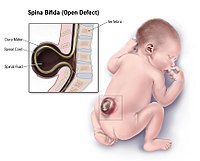
Photo from wikipedia
Study Design Retrospective review of Kids' Inpatient Database (KID). Purpose Identify the risks and complications associated with surgery in adolescents diagnosed with Chiari and scoliosis. Overview of Literature Scoliosis is… Click to show full abstract
Study Design Retrospective review of Kids' Inpatient Database (KID). Purpose Identify the risks and complications associated with surgery in adolescents diagnosed with Chiari and scoliosis. Overview of Literature Scoliosis is frequently associated with Chiari malformation (CM). More specifically, reports have been made about this association with CM type I in the absence of syrinx status. Methods The KID was used to identify all pediatric inpatients with CM and scoliosis. The patients were stratified into three groups: those with concomitant CM and scoliosis (CMS group), those with only CM (CM group), and those with only scoliosis (Sc group). Multivariate logistic regressions were used to assess association between surgical characteristics and diagnosis with complication rate. Results A total of 90,707 spine patients were identified (61.8% Sc, 37% CM, 1.2% CMS). Sc patients were older, had a higher invasiveness score, and higher Charlson comorbidity index (all p<0.001). CMS patients had significantly higher rates of surgical decompression (36.7%). Sc patients had significantly higher rates of fusions (35.3%) and osteotomies (1.2%, all p<0.001). Controlling for age and invasiveness, postoperative complications were significantly associated with spine fusion surgery for Sc patients (odds ratio [OR], 1.8; p<0.05). Specifically, posterior spinal fusion in the thoracolumbar region had a greater risk of complications (OR, 4.9) than an anterior approach (OR, 3.6; all p<0.001). CM patients had a significant risk of complications when an osteotomy was performed as part of their surgery (OR, 2.9) and if a spinal fusion was concurrently performed (OR, 1.8; all p<0.05). Patients in the CMS cohort were significantly likely to develop postoperative complications if they underwent a spinal fusion from both anterior (OR, 2.5) and posterior approach (OR, 2.7; all p<0.001). Conclusions Having concurrent scoliosis and CM increases operative risk for fusion surgeries despite approach. Being independently inflicted with scoliosis or Chiari leads to increased complication rate when paired with thoracolumbar fusion and osteotomies; respectively.
Journal Title: Asian spine journal
Year Published: 2023
Link to full text (if available)
Share on Social Media: Sign Up to like & get
recommendations!